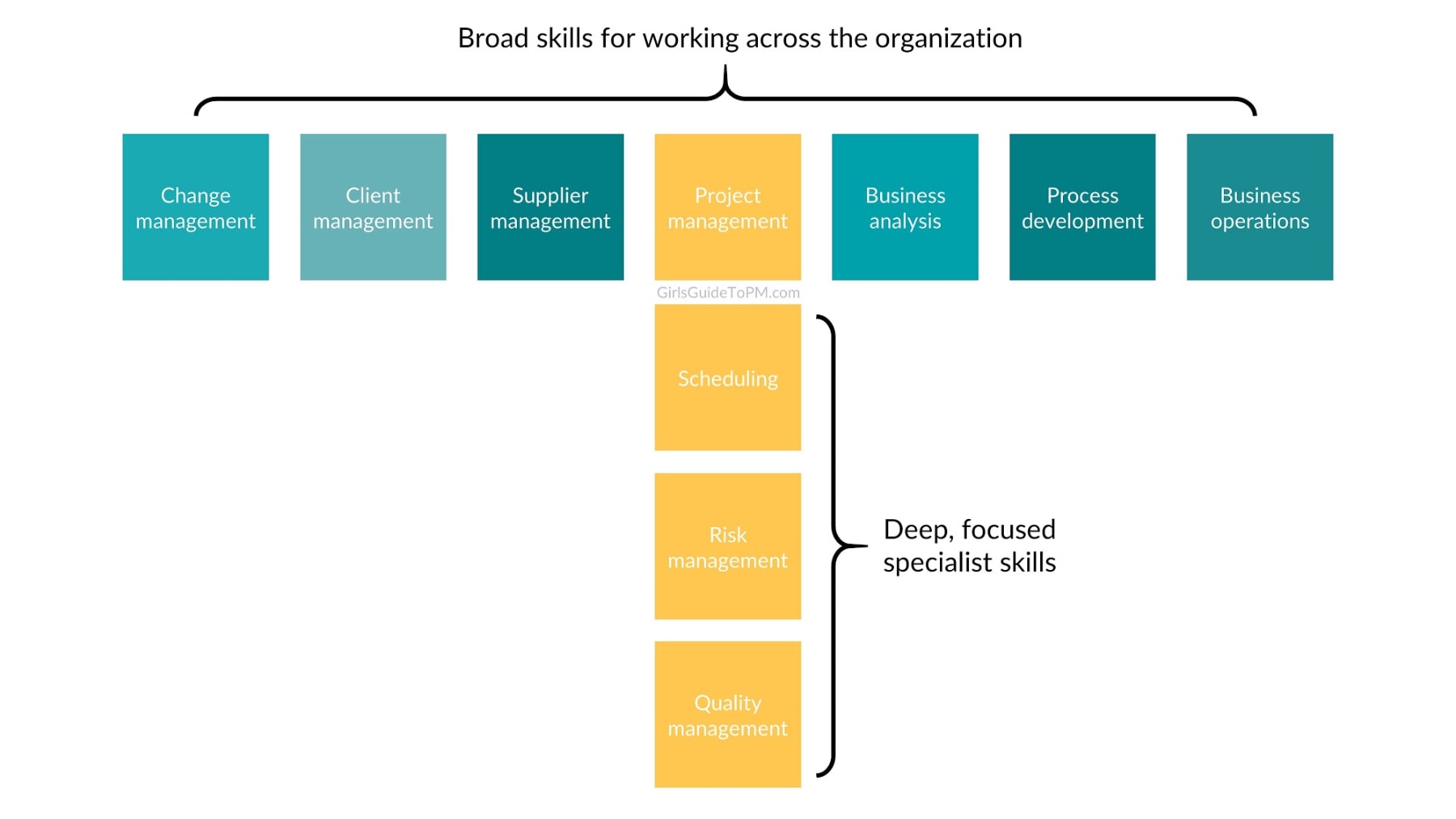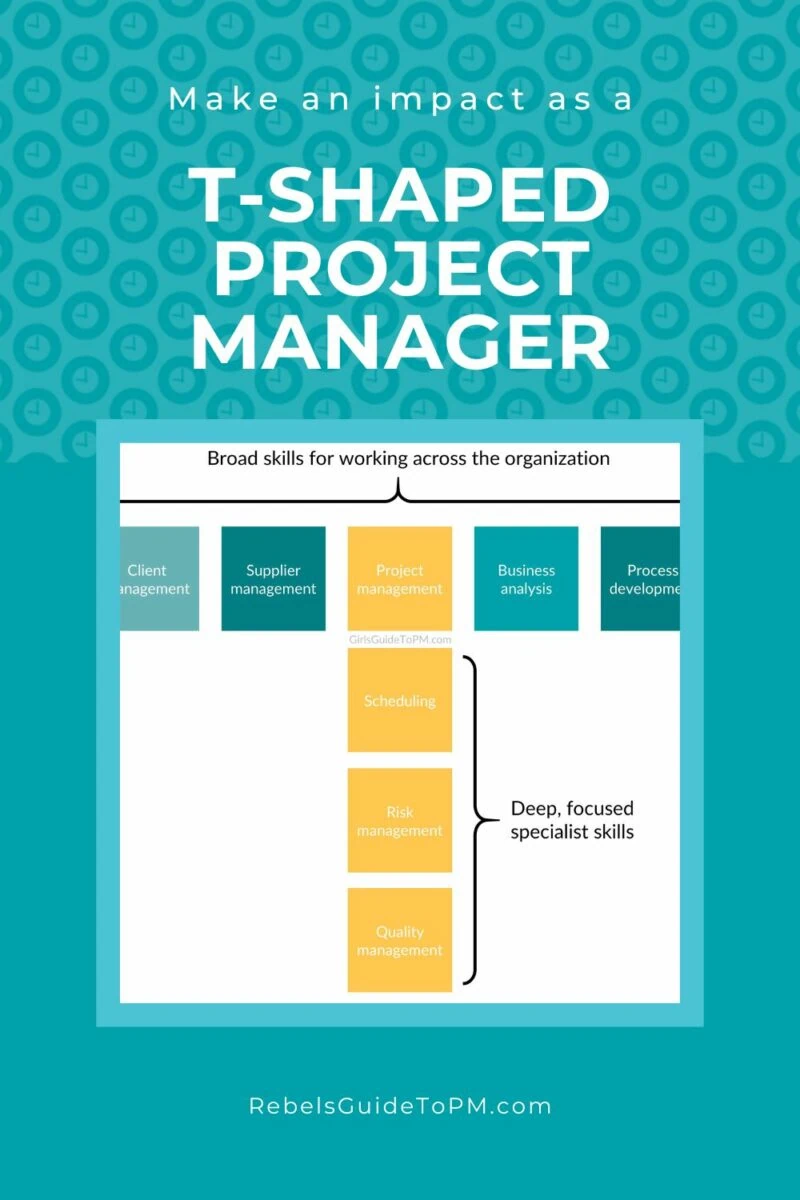Make an impact as a T-Shaped project manager
This blog is reader-supported. When you purchase something through an affiliate link on this site, I may earn some coffee money. Thanks! Learn more.
Have you ever heard of a T-shaped developer?
It’s a common phrase used in software development where the developer has broad experience in their role but is also profoundly skilled in one specific area.
The horizontal bar of the “T” represents their broader skill set. The vertical bar shows the more extraordinary and specialized skill: the depth of their knowledge.
If you are struggling to understand the visual reference, the image below may help.

A T-shaped developer’s ability to help different parts of a Development Team and still focus on a specific area makes them highly prized.
But can we apply the same principle to project management? I think we can.
The basics of a T-Shaped Individual
Firstly, it’s helpful to understand how T-shaped individuals differ from others. How can we classify people who aren’t T-shaped? What are the differences between T-shaped people and I-shaped people?
1. I-Shaped individuals have in-depth knowledge of a single subject.
2. Generalists, I think we’ll struggle to find a letter to match them, are capable of many duties but specialize in none.
T-shaped individuals allow us to do more with the same number of people. Or the same amount of work with fewer.
Why? Experts are great at being parachuted in and removing bottlenecks. They fix the problem quickly and the first time around.
However, not every task requires an expert. Offloading tasks to generalists will free up experts to be available for bottlenecks. The broader the cross-bar of the T, the more likely it is that a generalist will be able to complete the task.
T-shaped people create more availability for experts and non-experts alike. A team with T-shaped individuals can move and adapt quicker than ones without them. It’s a way of cross-skilling a team while still enabling people to be deep subject matter experts in the area that interests them.
What does it mean to be a T-shaped Project Manager?
There are different ways to consider T-shaped project managers.
The first is to judge all project manager skills inside the project management framework.
In this scenario, the broad skill set could include items such as ability to operate within the principles, tools and techniques of different approaches such as PRINCE2®, Kanban, Scrum, Sigma Six, or the PMBOK standards. If you’re an experienced project manager, you can probably do this as there is a great deal of overlap (especially in the area of soft skills — or power skills as PMI calls them) between published approaches and even internal methodologies that your organization might have adopted.
The deep focus would be on a single management framework or concept. For example, you could be an expert in earned value analysis, or risk modelling, or even the most experienced certified project management professional on the team and therefore the one who acts as the coach to everyone else.
An extreme example could be Jeff Sutherland. Jeff co-founded the Scrum framework, has specialized in it for over 30 years, and has written several books on the topic. He still has a working knowledge of other project management skills, though.
I’m not particularly a fan of this approach. As project managers, we need to reach into an in-depth toolkit of systems and processes to find the correct ones for each project.
Instead, another approach is to consider project management the deep skill set. In this scenario, a T-shaped project manager specializes in running complex projects.
So what is the broad skill set in that scenario? Well, it depends.
Project managers typically work in a specific industry. These different sectors require their own particular and broad skill sets.
Take my industry as an example: the digital sector, where we build complex websites and online portals. Our teams specialize in User Experience, Creative Design, Technical, Systems, and Commercial skills.
The Digital Project Managers who thrive best in this industry are the ones who can relate to each skill.
They are, in fact, T-shaped project managers.
So a T-shaped project manager is someone with a working knowledge of their teams’ skills. They don’t specialize like their colleagues but do have an understanding of the concepts and best practices.
The same applies with program managers. You could be a generalist or technical program manager and have either deep domain knowledge or a broad understanding of many topics that allows you to function successfully in the role.
Why are T-Shaped Project Managers vital?
There are various advantages to project managers being T-shaped.
By pulling insights from their team, a project manager has a better “finger on the pulse” of a project than I-shaped specialists. Great for working with stakeholders and playing the Multilingual Communicator role.
Project teams also often favor T-shaped project managers. Why? They like working through problems with people who talk their language. Project managers can often act as a mediator between specialists with strong opinions too.

As a project manager, we need to see risks and issues before others do. Having the ability to challenge a teammate in a stand-up or project meeting constructively can be useful.
A T-shaped professional is also highly praised in
The team expects project managers to help here, just like everyone else. An excellent example of this could be stepping in to test a product when your Testing team is busy.
Where are T-Shaped Project Managers most effective?
T-shaped project managers are capable of being dropped into different size organizations and thriving, when their skill set is well suited. However, smaller organizations suit them exceptionally well.
Why? The smaller the company, the more “hats” an individual needs to wear. (This can make the job a lot more fun and interesting for the person doing it too — a great way to build experience!)
As an organization grows, it can hire to replace parts of the role of others.
As mentioned above, project managers often get involved in product testing in smaller companies. A company will eventually reach a size to justify a full-time tester and free the project manager to focus on project delivery.
In my experience, project managers help in many differing roles in smaller companies. Client Management, Business Analyst, Change Manager and Product Ownership are other conventional roles a project manager does alongside their day job.
I-shaped project managers (those who don’t have the broad skill set of the cross-bar of the T) are often quickly overwhelmed by the scale of their responsibilities at smaller, and specialized, companies.

How do you develop T-Shaped Project Management Skills?
It’s not easy to build the depth and breadth skill set required to become T-shaped. It’s about building your business acumen and understanding the roles of your colleagues.
People take years perfecting their skills in their field. How do you do it as a project manager?
We are delivering projects, challenging colleagues, and training.
We need to remember that as project managers, we improve with every project we do. We gain a sixth sense through repetition. A time-consuming problem on a previous project becomes second nature to us later on.
Challenging your colleagues is an excellent way to broaden your skills and understand your project better. How you do this will depend on your sector. Putting yourself, and your colleagues, in the shoes of the project’s end-users, is always a great, and simple, first step.
Traditionally training has been an excellent way to upskill our in-experiences too.
While in-depth and specialized training can be expensive, there are several inexpensive routes to get basic training for new subjects. For example, I’ve used Coursera for online courses in Product Development and User Experience.
Want to take this even further? Follow industry leaders and what they share online. I learnt more on the technical basics of digital project delivery from this guide than from any official training.
Finally, a T-shaped project manager is someone who has a working knowledge of their teams skills. It’s crucial to appreciate that it’s harder to achieve this status by regularly switching sectors.
Wrapping up
You don’t become a T-shaped project manager overnight. It’s a gradual process and enormously challenging for someone in a new industry.
Yet, it’s also a journey that can lead to substantial benefits to both you and your team, especially in smaller organizations. T-shaped project managers are credible, help remove project bottlenecks, and add value.
So think about how you can become more rounded.
It might be through training, greater collaboration, or just getting more projects under your belt. Either way, your team will appreciate you for it.
